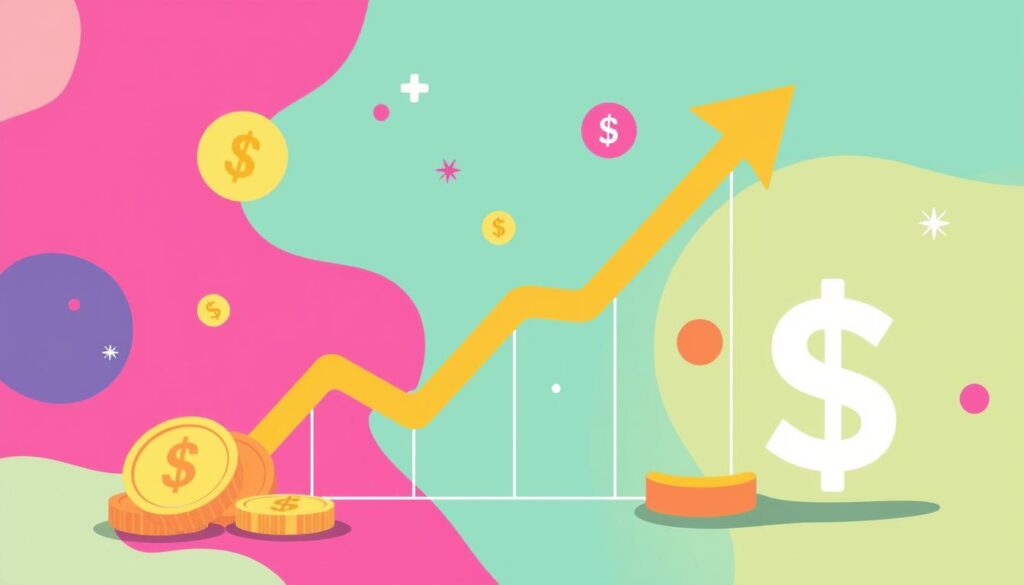
Interest rates are key in finance, affecting loans, mortgages, investments, and the economy. For beginners, grasping interest rates can seem tough. But, it’s vital for smart financial choices. This guide will help you understand interest rates, their role, and how they affect personal finance and Nigeria’s economy.
Key Takeaways
- Interest rates are the cost of borrowing money or the return on saving or investing it.
- Interest rates can be influenced by various factors, including the central bank’s monetary policy, economic indicators, and market forces.
- Understanding the different types of interest rates, such as simple and compound interest, is crucial for making informed financial decisions.
- Interest rates play a significant role in borrowing, saving, and investing, with their impact on personal finance and the broader economy.
- Inflation and risk-return relationships are important considerations when understanding interest rates and their impact.
What are Interest Rates?
Interest rates are key in finance. They show the cost of borrowing or the gain from saving. Knowing about interest rates is essential for understanding the financial world.
Definition and Importance
Interest rates are the percentage charged by lenders for using assets. They are crucial in finance, affecting loans, mortgages, and the economy. Rates influence spending, inflation, and market performance.
Types of Interest Rates
There are many types of interest rates, each with its own use:
- Fixed Interest Rates – These rates stay the same, offering stability.
- Variable Interest Rates – These change with the market, often linked to the prime rate or LIBOR.
- Nominal Interest Rates – These rates are stated before adjusting for inflation. Real Interest Rates account for inflation.
Knowing the different interest rates helps in making smart financial choices. This is true for borrowers, savers, and investors.
“Interest rates have a profound impact on the economy, affecting everything from consumer spending to business investments and the overall performance of financial markets.”
Factors Influencing Interest Rates
Interest rates are key in the economy, affecting businesses and consumers. Knowing what affects them is vital for smart financial choices. In Nigeria, the Central Bank of Nigeria (CBN) sets policies that shape interest rates.
The central bank policy is a major factor. The CBN’s decisions on the Monetary Policy Rate (MPR) impact the economy. They adjust the MPR to control inflation, boost growth, and keep the naira stable.
Economic indicators like inflation, GDP, and unemployment also matter. High inflation might lead to higher rates to control spending. Slow growth could mean lower rates to encourage borrowing.
| Economic Indicator | Impact on Interest Rates |
|---|---|
| Inflation | Higher inflation typically leads to higher interest rates |
| GDP Growth | Stronger economic growth often results in higher interest rates |
| Unemployment | Higher unemployment may prompt the central bank to lower interest rates |
Lastly, global economic conditions affect Nigeria’s rates too. Major central banks’ policies, commodity prices, and global economic health influence Nigerian markets and rates.
Understanding these factors influencing interest rates helps Nigerians and businesses. It aids in making better financial decisions and managing investments.
Understanding Interest Rates in Nigeria
Nigeria’s interest rates are key to its financial health. The Central Bank of Nigeria (CBN) controls these rates. It’s the top financial body in the country.
Central Bank of Nigeria’s Role
The Central Bank of Nigeria (CBN) keeps the economy stable. Its Monetary Policy Committee (MPC) sets interest rates. They meet to decide on rates based on the economy.
Economic Indicators and Rates
Many factors affect Nigeria’s interest rates. These include inflation, GDP growth, and the exchange rate. The CBN watches these closely and adjusts the interest rates as needed.
- Inflation: High inflation rates often lead the CBN to raise interest rates to curb inflationary pressures and maintain price stability.
- GDP Growth: The CBN may adjust interest rates to stimulate or slow down economic growth, depending on the prevailing economic conditions.
- Exchange Rate: The exchange rate between the Nigerian Naira and other major currencies can also impact interest rates, as the CBN may use rate adjustments to manage currency fluctuations.
| Economic Indicator | Impact on Interest Rates |
|---|---|
| Inflation | Higher inflation typically leads to higher interest rates |
| GDP Growth | Stronger economic growth may prompt the CBN to raise rates |
| Exchange Rate | Currency volatility can influence the CBN’s interest rate decisions |
Knowing how the Central Bank of Nigeria works helps people and businesses in Nigeria. They can make better choices about money, loans, and investments.
Simple vs. Compound Interest
Understanding interest rates means knowing the difference between simple and compound interest. Simple interest is easy to calculate. It depends on the principal, the interest rate, and how long you keep the money. Compound interest adds the interest you’ve already earned to the principal. This means it earns more interest over time.
Calculating Simple Interest
Simple interest is easy to figure out. The formula is: Simple Interest = Principal x Rate x Time. For instance, if you borrow ₦10,000 at 5% interest for 3 years, you earn ₦1,500. This is calculated by multiplying ₦10,000 by 0.05 and then by 3.
- The principal amount is the initial sum of money involved.
- The interest rate is the percentage charged or earned on the principal.
- The time period is the duration for which the interest is calculated.
Simple interest is common in short-term loans. It makes it easy to know how much you owe or will earn.
“Understanding the difference between simple and compound interest is crucial for making informed financial decisions.”
The main difference between simple and compound interest is how they calculate interest over time. Simple interest only adds to the principal. Compound interest adds to the principal and the interest already earned.
Interest Rates and Borrowing
Interest rates are key when borrowing money. They affect the cost of loans and mortgages, impacting how much you owe. It’s important to know how rate changes can affect your borrowing choices.
Loans and Mortgages
Loans, personal or business, are influenced by interest rates. Higher rates mean more expensive borrowing, leading to bigger payments. Lower rates make borrowing cheaper, helping you get credit at a lower cost.
Mortgages, a big loan type, feel rate changes a lot. Higher rates make buying a home harder, as payments go up. But, lower rates make homes more affordable, reducing borrowing costs.
| Loan Type | Average Interest Rate | Monthly Payment (on a $100,000 loan) |
|---|---|---|
| Personal Loan | 12.50% | $1,088 |
| Auto Loan | 6.75% | $1,609 |
| Mortgage (30-year fixed) | 8.25% | $733 |
The table shows how rates affect monthly payments on different loans. Higher rates mean bigger costs, so it’s key to think about rate changes.
“Understanding the relationship between interest rates and borrowing is crucial for making informed financial decisions.”
Knowing about interest rates and borrowing helps you make better choices. This is true for loans, mortgages, and other credit types.
Interest Rates and Savings
Understanding the link between interest rates and savings is key. Interest rates affect how much you earn on your savings. It’s vital to keep up with rate changes and their effect on your savings.
In Nigeria, the Central Bank of Nigeria (CBN) sets the benchmark interest rates. These rates influence what banks offer. When rates go up, your savings account can earn more. But, when rates drop, your earnings might fall too.
To grow your savings, compare rates from different places. Choose the one that fits your goals. Also, watch economic signs like inflation and GDP growth. This helps you pick the best spot for your savings.
- Interest rates directly affect the earnings on savings accounts and other savings instruments.
- Higher interest rates mean more money in your savings. Lower rates mean less.
- Keeping an eye on rate trends and economic signs helps you make smart choices about your investment returns and savings plan.
By grasping how interest rates and savings interact, you can make better choices. This ensures your savings grow and help you reach your financial goals.

Understanding Interest Rates for Investments
Interest rates are key in investments. Knowing how they affect different types, like bonds and stocks, helps in making smart choices. Let’s look at how interest rates influence these investment options.
Fixed Income Securities
Fixed income securities, like bonds, are very sensitive to interest rates. When rates go up, the value of bonds usually goes down. This is because new bonds with higher rates look better. On the other hand, when rates drop, bond values go up, making them more attractive to investors.
Equities and Interest Rates
The link between interest rates and stocks is complex. When rates rise, borrowing costs go up, which can hurt corporate profits and stock prices. This makes bonds seem more appealing, possibly drawing investors away from stocks. Yet, how interest rates affect stocks can change based on the industry, the economy, and what investors think.
It’s crucial for investors to keep up with interest rate changes. By understanding these shifts, they can make better choices and adjust their plans as the investment world changes.
“Successful investing is about managing risk, not avoiding it.” – Benjamin Graham
The Impact of Inflation on Interest Rates
It’s key to know how inflation and interest rates are linked. Inflation is when prices for goods and services keep going up. This can really affect the interest rates in an economy.
When prices go up, banks often raise interest rates. This makes borrowing costlier and encourages saving. It helps slow down inflation. On the flip side, if prices are low, banks might lower interest rates. This helps the economy grow and boosts spending.
The real interest rate is vital. It shows the true value of money after inflation. It tells us the real return on savings or the real cost of borrowing.
| Scenario | Nominal Interest Rate | Inflation Rate | Real Interest Rate |
|---|---|---|---|
| Low Inflation | 5% | 2% | 3% |
| High Inflation | 8% | 6% | 2% |
The table shows how inflation affects real interest rates. Low inflation means higher real interest rates, giving savers more power. High inflation means lower real interest rates, reducing purchasing power.
Knowing how inflation and interest rates work helps us make better financial choices. This is true for getting loans, investing, or saving money.
Understanding Interest Rates and Risk
When you make financial choices, knowing about interest rates and risk is key. Higher interest rates mean more risk, as lenders want more for the chance of losing money.
Risk-Return Relationship
The risk-return rule is basic in finance. High-risk investments might give you more money, but they’re riskier. Low-risk ones offer less but are safer. This rule also works for interest rates.
For instance, bonds from companies with bad credit scores have higher interest rates. This is because lenders want more for the risk. Government bonds are safer, so they have lower rates.
| Investment Type | Interest Rate | Risk Level |
|---|---|---|
| Government Bonds | Low | Low |
| Corporate Bonds (Investment Grade) | Moderate | Moderate |
| Corporate Bonds (High Yield) | High | High |
| Emerging Market Debt | High | High |
When investing, think about the risk-return balance and your goals. Spreading out your investments can help with interest rate changes and risk.

“Investing should be more like watching paint dry or watching grass grow. If you want excitement, take $800 and go to Las Vegas.” – Paul Samuelson
Interest Rate Cycles and Economic Growth
The link between interest rate cycles and economic growth is complex. Interest rates, set by central banks, shape business cycles and economic performance. It’s key for everyone to grasp this connection.
When the economy grows too fast, central banks raise interest rates. This makes borrowing more expensive, slowing down spending and investment. On the other hand, during downturns, they lower rates to boost borrowing and spending, helping the economy grow.
Interest rates’ cycles affect the economy through various economic indicators. For example, changes in unemployment, GDP, and consumer confidence show the impact of interest rate cycles. Knowing these patterns helps businesses and individuals make better financial choices.
| Economic Indicator | Impact of Rising Interest Rates | Impact of Falling Interest Rates |
|---|---|---|
| Unemployment Rate | Tends to increase | Tends to decrease |
| Gross Domestic Product (GDP) | Tends to slow down | Tends to accelerate |
| Consumer Confidence | Tends to decrease | Tends to increase |
By understanding interest rate cycles and their effect on economic growth, we can prepare for market changes. This knowledge helps in making better investment and borrowing decisions, leading to more informed financial planning.
“Understanding the interplay between interest rates and the broader economy is crucial for making informed financial decisions. By recognizing the cyclical patterns, individuals and businesses can navigate the ever-changing economic landscape with greater confidence and success.”
Strategies for Managing Interest Rate Fluctuations
When interest rates change, it’s important for people and businesses to act fast. Two main ways to handle these changes are diversification and asset allocation.
Diversification
Spreading out your investments is key to reducing risk from interest rate changes. By having a mix of stocks, bonds, and real estate, you can protect your portfolio from big swings in interest rates.
- Invest in a variety of fixed-income securities, like government bonds and corporate bonds, to balance risk.
- Look into other investments, such as real estate or commodities, which might do better when interest rates are unstable.
- Investing in international markets can also help diversify your portfolio and reduce risk.
Asset Allocation
Changing your asset allocation is another smart move to handle interest rate fluctuations. By picking the right mix of assets, you can better handle changes in interest rates.
- Put more money into short-term fixed-income securities, like Treasury bills, which are less affected by rate changes.
- Adjust your investment in longer-term bonds based on your view of future interest rates and their impact on bond prices.
- Think about adding floating-rate investments, like adjustable-rate mortgages, which can protect against rising rates.
By using diversification and smart asset allocation, you can tackle the challenges of interest rate changes. This way, you can keep your investments strong for the long haul.
“The key to managing interest rate risk is to maintain a well-diversified portfolio and continuously monitor and adjust your asset allocation as market conditions change.”
Conclusion
In this guide, we’ve explored interest rates and their big impact on money matters and the economy in Nigeria. We’ve looked at what interest rates are, their types, and what affects them. This journey into the world of interest rates is deep and complex.
Interest rates are key in deciding how much you pay to borrow money, how much you earn on savings, and how well investments do. Knowing about interest rates helps Nigerians make smart choices. This is true whether you’re looking to borrow, save, or invest.
As you start your financial journey, knowing about interest rates is very important. Use what you’ve learned from this article to make smart financial decisions. This will help you achieve your financial goals and secure a better future.





